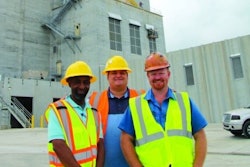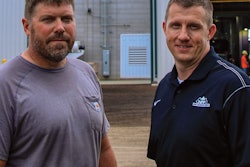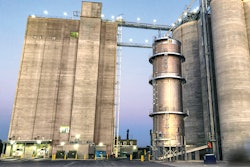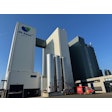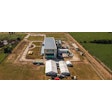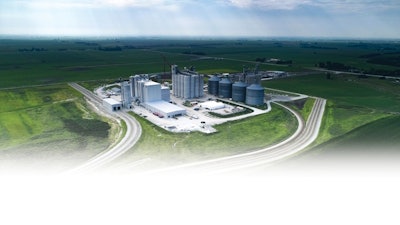
The United States’ largest flour mill in terms of production capacity at 30,000 cwts/day opened its doors 90 miles from the Windy City in Mendota, IL, last fall. The idea was hatched in 2015, when Chicago-based ADM began discussing how the company could better meet increased flour demand across Illinois, Indiana, Wisconsin and Iowa.
They decided to invest in support of the region’s growing appetite for baked goods by building the company’s largest flour mill from scratch — the fourth largest in North America.
The new mill was also a crucial part of ADM’s strategy to centralize flour production and close three aging, smaller flour mills located in Salina, KS, Minneapolis and Chicago, whose combined milling capacity was just under
30,000 cwts.
In order to maximize their own infrastructure and storage assets, a cross-departmental team at ADM concluded they would build the new mill at one of their existing grain elevators and evaluated several Midwestern locations for expansion.
They ultimately selected the 2.75-million-bushel Mendota grain elevator that ADM purchased from Fasco Mills in 2007 because of its proximity to wheat markets and major transportation systems like I-39, I-80 and the BNSF railway. A big advantage was Mendota’s loop track with the capacity to ship and receive a 110-car unit train.
“We also had knowledge of the talent pool in the region and their hard work ethic,” James Harper, Mendota mill general manager says. “The ability to provide both employment opportunities and a local market for grain producers here were two major contributors to that decision.”
Through a bidding process, ADM chose Younglove Construction LLC as the design/build/engineer for the massive project. Initial construction started in June 2017 and was completed in September 2019. Construction included two 35-foot-diameter silos for midds byproduct and two 10-packs of slipform concrete silos for an additional 2 million bushels of wheat storage, bringing the elevator’s total storage capacity to 4.75 million bushels.
The milling facility — made up of an A, B and C mill — produced its first batches of flour in July 2019 and is running at maximum capacity today with a staff of approximately 50 employees.
Milling operations
The 186,000-square-foot facility is split into three milling units and cleaning houses, each standing seven stories tall and designed to produce 10,000 cwts flour/day. The A unit mills hard red winter wheat, the B unit mills spring wheat, while the C unit is a swing mill, capable of grinding soft wheat, hard wheat or reconstituted whole wheat from red winter or spring wheat.
Wheat deliveries come into the mill by truck or rail car, undergo testing and are stored in the grain elevator.
“We have onsite testing capabilities as part as our collaborative effort with ADM’s ag services team that enable us to analyze incoming wheat to ensure it meets our standards for milling,” Harper says.
To begin milling flour, wheat is blended to meet specifications and transferred to one of the cleaning houses. The product is then cleaned for impurities with an Ocrim grain separator, aspirator and three Cimbria color sorters. Next, the wheat is tempered for up to 24 hours on a first-in-first-out basis before passing through the scourer-aspirators and entering the break process.
After cleaning, the milling operation involves a combination of 18 double-high and 47 single-high Ocrim roll stands, eight 10-section Ocrim sifters, four eight-section Ocrim sifters and 14 Ocrim purifiers.
Loadout
The finished flour is put into storage bins and transferred through a final loading system to either the Premier Tech high-speed packaging line or one of the bulk loading systems, which includes truck and rail.
There are three bulk truck loadouts and the facility can load more than 60 bulk trucks/day. Rail loadout is rated at 50,000 bushels/hour and Harper says the staff will load one 110-car unit train/week once unit train deliveries begin.
The high-speed packaging line that resides inside a 30,000-square-foot warehouse fills 25- or 50-pound bags at approximately 18 bags/minute. Bags are loaded onto trucks in one of three loading bays.
The mill also has a truck wash for its on-site transportation company operated by Foodliner, which uses advanced load tracking RFID technology.
Harper takes pride in delivering quality finished product.
“We have a new lab with the most up-to-date, quality control equipment,” he says. “We perform industry standard tests, as well as several additional tests tailored to meet our own quality standards.”
Harper also noted building the mill from the ground up allowed ADM to integrate specialized solutions like a closed loop variable frequency drive for exhausting, a pneumatic system that produces energy savings, self-cleaning flour drags, an in-house vacuum system and a windowless design to help ensure proper sanitation. ■
GROWER CONNECT PROGRAM
With consumers seeking a greater connection to their food and more transparency in the food system, ADM knows that the stories of the people and places behind their ingredients are more important than ever. That dynamic led to the creation of Grower Connect, providing a link from farm to table. The program builds relationships with local growers through continued conversations during the growing and harvest season. Through these connections, ADM benefits from a consistent, high-quality grain supply to its mills.
The program provides ADM customers with online profiles about the growers who work with ADM to provide quality grains. Producers near the Mendota flour mill have gained new market opportunities, an option to participate in a cover crop cost share program and a valuable partner in sustainability.
“The Mendota mill has attracted a number of new producers to ADM. We created a destination market for soft red winter wheat and producers in northern Illinois were eager to introduce wheat into their crop rotations for variety of reasons, sustainability being among them,” James Harper, Mendota mill general manager, says. “We’re working to help expand production of wheat through our work with seed companies and we’ve partnered with Pepsi and Practical Farmers of Iowa to offer a cover crop cost share program that has been very successful with local growers.”
Offering growers benefits for participating in such programs positions ADM to maintain a consistent wheat supply well into the future to meet flour demand.
TAKE A VIRTUAL TOUR
Get an up-close look at the largest U.S. wheat mill ever built from the ground up.
ADM’s newly opened Mendota, IL, flour mill employs state-of-the-art processing technology and equipment to produce up to 30,000 cwts of flour/day.
ADM showcases the world-class mill with a new video featuring drone footage, a time-lapse of concrete bin erection and a glimpse into the inner workings of the facility’s automation system, testing lab, high-speed packaging line and 30,000-square-foot warehouse.



